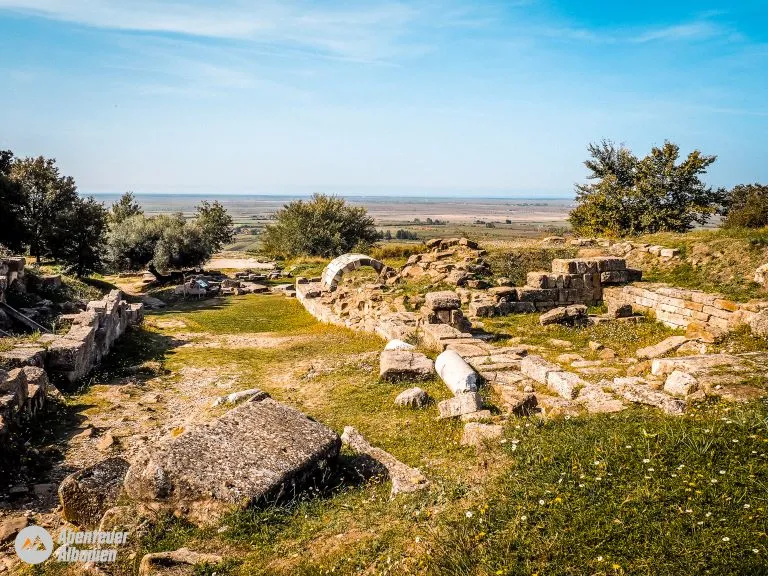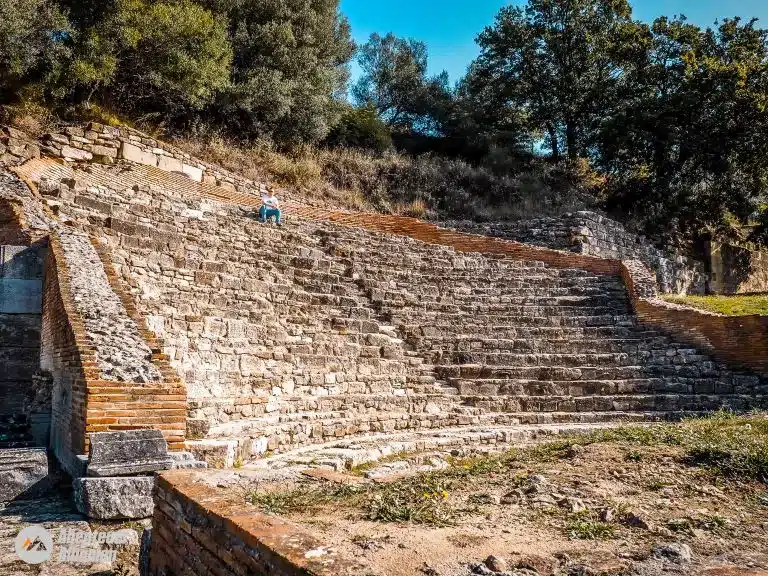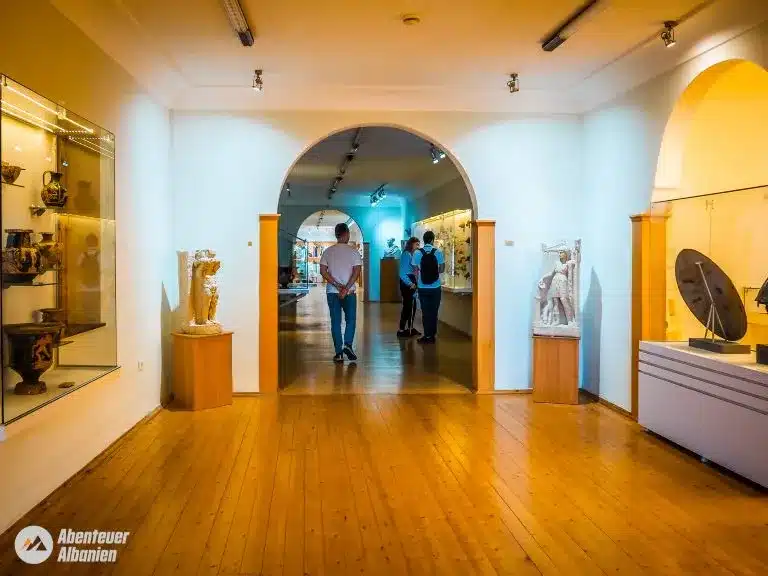How to visit the ancient ruins of Apollonia in Albania
The Apollonia ruins, located in Pojan near the city of Fier in Albania, are one of Albania’s most important archaeological sites in the country. In Roman times Apollonia was one of the largest cities in the Adriatic. Its monastery shows a mix of western and eastern architectural traditions. The grounds of the park are home to the endangered Hermann’s tortoise.
During our road trip through adventurous Albania, my friend Jan and I were able to visit a number of historical attractions. Today’s travel tip, the ruins of Apollonia, is not a castle, but an archaeological excavation site with mainly Greek ruins, similar to those of Butrint or Finiq in southern Albania.

The archaeological site of Apollonia is very extensive and invites you to take long walks through the ruins and trees, which provide pleasant shade during hot summer days.
Table of Contents
Quick facts
Apollonia can easily be reached by car. From the closest major city, Vlore, it is about a 40 minute drive (36 km). Getting to Apollonia from Tirana takes about 2 hours. There are also buses from Vlore, but from what I learned their schedule seems rather infrequent and not reliable. Exploring the archeological site walking will take you about 2 hours and I recommend visiting during the morning when temperatures are pleasant. The park of Apollonia is open 09:00 – 19:00 hrs during the main season between Mai and October
- Location: Apollonia Archaeological Park
- Best time to visit: Spring and autumn
- Opening times: 09am – 7pm during the main season
- Admission: 400 Lek (around €4)
Visiting the Archeological museum of Apollonia (highly recommended) costs another 600 Lek.

Highlights:
If you’re pressed for time most of the highlights are close to the entrance and a quick visit to the neat museum can suffice.
General information about the ruins of Apollonia
The archaeological site of Apollonia, named after the Albanian excavation site, is the most important of its kind in Albania, along with the site of Butrint in the far south of the country. It is one of the few Greek colonies that existed on the Adriatic.
History of Apollonia
The ancient city that is now a ruin was founded in 588 BC and was an important urban centre in the region for about a thousand years. It is said that up to 60,000 people lived and worked there.
The Greek colony was founded on the former course of the Vjosa river and named after the god Apollo, like many other Greek colonies in the Mediterranean. The location on the hill offered and still offers good views of the region. You can even see as far as the sea.

The fertile soil and flourishing trade brought great prosperity to the inhabitants, and just 200 years after its founding, 100 hectares of land had been occupied. This economic strength also helped the city maintain its political independence during the period of Roman rule. There is also a connection to ancient Amantia, which was subjugated by Apollonia. In Amantia, you can still see the ancient stadium in front of an impressive mountain backdrop.
In the 4th century BC, the city was conquered by Alexander the Great and later became a protectorate of Rome. During the civil war between Julius Caesar and Pompey (49-45 BC), Apollonia sided with Caesar, who was later victorious. And during his rule as dictator, his grand-nephew and heir Octavian Augustus studied oratory in Apollonia, one of the great educational centres of the Greco-Roman world.
But as so often, economic strength did not last forever. The course of the river changed after a strong earthquake, and the up-and-coming city of Vlora posed competition for Apollonia.
Although the former port city was never destroyed by people, but rather simply abandoned, only 5% of the remains have been excavated and archaeologically processed. And this despite the fact that the ancient ruins were identified as the remains of Apollonia as early as the 15th century. So there is still plenty of potential here in Apollonia.
What to see and what to expect
A tour of the ruins of Apollonia begins with the area that archaeologists call the monumental centre. The most important building here and in the whole of Apollonia is the impressive Bouleuterion.
The Bouleuterion

The building served as a town hall or assembly hall where the city officials held their meetings. As such, it was once equipped with tribunes, but only the facade remains. The Bouleuterion was built in the 2nd century AD. It is also known as the Agonothetes Monument, in honour of the magistrates who were responsible for organising the holidays.
The Odeon
The best-preserved building in the city centre, after the Bouleuterion itself, is the Odeon, which stands directly opposite. The building, which could seat around 300 people, was once the venue for assemblies and musical performances.

A side trip to the Acropolis on the hill at the edge of the excavation site is also worthwhile. From there, you have a great view, even as far as the sea. It is also exciting to search for the remains of the theatre, which we could only see and reach after a lot of searching from the Acropolis.
The Archeological Museum of Apollonia – Recommended
Before or after visiting the ruins, be sure to visit the museum, which is located in a well-preserved Byzantine monastery. The main building in the complex is the Church of St. Mary (Shen Merise), which dates back to the 11th century (or 13th, depending on the source). The monastery still looks amazing, but it was disturbing to learn that most of the stone for it was stolen from the nearby ruins, causing irreparable damage to the archaeological site.

Inside the church, the original appearance of the nave with its frescoes has been preserved. There is also a well-preserved bell tower and a refectory in the monastery complex. The rest of the monastery complex houses various artefacts and sculptures from the pre-Christian era of Apollonia.
Highlights include lion sculptures that were once placed in front of a tomb and sculptures of various locals, some of which were also found in graves. Numerous smaller pieces, reminiscent of the Greek pantheon, can also be found in the corridors.

You should definitely go up to the second floor to see a large collection of smaller artefacts. Highlights include portraits of various local nobles and Roman emperors. There is also an interesting hunting relief from the Hellenistic period and a bronze urn, among other things.

You will find that many busts in the museum are missing their heads. They are to be found in Tirana, for example in the National Archaeological Museum (if it’s open – it may be closed for renovations). Here you’ll find busts of Apollonia locals, portraits of Roman emperors like Hadrian, and a full-sized statue of a local man in excellent condition.
There is also a restaurant on the site, which is located on the hill of Apollo. The monastery of Shen Merise is also located on the site of the archaeological site and has been there for several hundred years.
How do I get to the ruins of Apollonia?
The archaeological site of Apollonia is easy to reach, as it is only a few kilometres from the city of Fier near Vlore, well-connected by the SH4 and SH94 as well as SH66 roads in Albania.
Once you arrive, you quickly realise that the place has not yet been fully developed for tourism. You can simply park your car in the meadow in front of the site. Depending on the number of visitors, you can even park in the shade of the trees.
There are also organised day trips from Tirana that will provide all transport and logistics for you. Try GETYOURGUIDE for a hassle-free transfer.
Conclusion
Apollonia is a significant classical Greco-Roman archaeological site with a fine central area of excavated structures in reasonably good condition – Bouleterion, Libraries, Odeon etc are well worth visiting. For a nice walk through the ruins and up to the Acropolis, a visit to the archaeological site of Apollonia is definitely worthwhile.
In summary, we liked our walk through the ruins of Apollonia. The ancient excavations can be easily explored on your own. However, we recommend taking a guidebook with you to read up on the history of the place, because there is really little information on site. This seems a bit of a shame as it is managed much better in Butrint.
Official website: https://apolloniaarchaeologicalpark.al/en/home/

